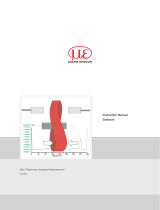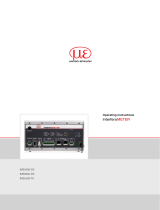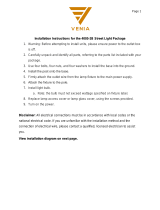Page is loading ...

Instruction Manual
combiSENSOR 64x0

MICRO-EPSILON
MESSTECHNIK
GmbH & Co. KG
Königbacher Straße 15
94496 Ortenburg / Germany
Tel. +49 (0) 8542 / 168-0
Fax +49 (0) 8542 / 168-90
e-mail [email protected]
www.micro-epsilon.com

combiSENSOR 64x0
Contents
1. Safety ........................................................................................................................................ 7
1.1 Symbols Used ................................................................................................................................................. 7
1.2 Warnings .......................................................................................................................................................... 7
1.3 Notes on CE Marking ...................................................................................................................................... 8
1.4 Intended Use ................................................................................................................................................... 8
1.5 Proper Environment ......................................................................................................................................... 9
2. Functional Principle, Technical Data ..................................................................................... 10
2.1 Measuring Principle ....................................................................................................................................... 10
2.1.1 Capacitive Principle ...................................................................................................................... 10
2.1.2 Eddy Current Principle ................................................................................................................. 11
2.1.3 Thickness Measurement .............................................................................................................. 11
2.2 Structure ........................................................................................................................................................ 13
2.2.1 Sensor .......................................................................................................................................... 13
2.2.2 Sensor Cable ................................................................................................................................ 14
2.2.3 KSS64x0 Controller ...................................................................................................................... 14
2.3 Technical Data ............................................................................................................................................... 15
3. Delivery ................................................................................................................................... 16
3.1 Unpacking, Included in Delivery.................................................................................................................... 16
3.2 Storage .......................................................................................................................................................... 16
4. Installation and Assembly ...................................................................................................... 17
4.1 Precautionary Measures ................................................................................................................................ 17
4.2 Sensor ............................................................................................................................................................ 17
4.3 Sensor Cable ................................................................................................................................................ 19
4.4 Controller ....................................................................................................................................................... 20
4.5 Ground Connection, Earthing ....................................................................................................................... 22
4.6 Electrical Connections ................................................................................................................................... 23
4.6.1 Connectivity Options ................................................................................................................... 23
4.6.2 Pin Assignment Supply, Trigger ................................................................................................... 24
4.6.3 Analog Output .............................................................................................................................. 24
5. Operation ................................................................................................................................ 26
5.1 Starting Up ..................................................................................................................................................... 26
5.2 LED’s on the Controller ................................................................................................................................. 27

combiSENSOR 64x0
5.3 Triggering ....................................................................................................................................................... 27
5.4 Measurement Averaging ............................................................................................................................... 29
5.4.1 Introduction .................................................................................................................................. 29
5.4.2 Moving Average ............................................................................................................................ 29
5.4.3 Arithmetic Average Value ............................................................................................................. 30
5.4.4 Median .......................................................................................................................................... 30
5.4.5 Dynamic Noise Rejection ............................................................................................................. 30
6. Ethernet Interface ................................................................................................................... 31
6.1 Hardware, Interface ....................................................................................................................................... 31
6.2 Data Format of Measuring Values ................................................................................................................. 34
6.3 Settings .......................................................................................................................................................... 36
6.4 Commands .................................................................................................................................................... 36
6.4.1 Data Rate (STI) ............................................................................................................................. 37
6.4.2 Trigger Mode (TRG) ...................................................................................................................... 38
6.4.3 Get Measured Data (GMD)........................................................................................................... 38
6.4.4 Filter, Averaging Type (AVT) ......................................................................................................... 39
6.4.5 Filter, Averaging Number (AVN) ................................................................................................... 39
6.4.6 Thickness Measurement (THM) ................................................................................................... 40
6.4.7 Thickness Zeroing (THZ) .............................................................................................................. 40
6.4.8 Channel Status (CHS) .................................................................................................................. 40
6.4.9 Status (STS).................................................................................................................................. 41
6.4.10 Version (VER) ............................................................................................................................... 41
6.4.11 Ethernet Settings (IPS) ................................................................................................................. 41
6.4.12 Change between Ethernet and EtherCAT (IFC = Interface) ....................................................... 42
6.4.13 Query Data Port (GDP) ................................................................................................................. 42
6.4.14 Set Data Port (SDP) ...................................................................................................................... 42
6.4.15 Access Channel Information (CHI)............................................................................................... 43
6.4.16 Access Controller Information (COI) ............................................................................................ 43
6.4.17 Login for Web Interface (LGI) ....................................................................................................... 44
6.4.18 Logout for Web Interface (LGO) ................................................................................................... 44
6.4.19 Change Password (PWD)............................................................................................................. 44
6.4.20 Change Language for the Web Interface (LNG) .......................................................................... 45
6.4.21 Default Messages ........................................................................................................................ 45

combiSENSOR 64x0
6.5 Operation Using Ethernet .............................................................................................................................. 45
6.5.1 Requirements ............................................................................................................................... 45
6.5.2 Access via Web Interface ............................................................................................................. 47
6.5.3 Thickness Measurement .............................................................................................................. 50
6.5.4 Trigger Mode ................................................................................................................................ 52
6.5.5 Data Rate ...................................................................................................................................... 52
6.5.6 Filter, Averaging ............................................................................................................................ 52
6.5.7 Digital Interfaces ........................................................................................................................... 53
6.6 Firmware Update ........................................................................................................................................... 53
7. EtherCAT Interface ................................................................................................................. 54
7.1 Introduction .................................................................................................................................................... 54
7.2 Change Interface ........................................................................................................................................... 54
8. Operation and Maintenance .................................................................................................. 55
9. Liability for Material Defects .................................................................................................. 56
10. Decommissioning, Disposal .................................................................................................. 56
Appendix
A 1 Accessories ............................................................................................................................ 57
A 2 EtherCAT Documentation ...................................................................................................... 58
A 2.1 Preamble ........................................................................................................................................................ 58
A 2.1.1 Structure of EtherCAT®-Frames .................................................................................................. 58
A 2.1.2 EtherCAT® Services ..................................................................................................................... 59
A 2.1.3 Addressing and FMMUs ............................................................................................................... 60
A 2.1.4 Sync Manager .............................................................................................................................. 60
A 2.1.5 EtherCAT State Machine .............................................................................................................. 61
A 2.1.6 CANopen over EtherCAT.............................................................................................................. 62
A 2.1.7 Process Data PDO Mapping ........................................................................................................ 62
A 2.1.8 Service Data SDO Service ............................................................................................................ 62
A 2.2 CoE – Object Directory .................................................................................................................................. 63
A 2.2.1 Communication Specific Standard Objects (CiA DS-301) .......................................................... 63
A 2.2.2 Manufacturer Specific Objects ..................................................................................................... 65
A 2.3 Measurement Data Format ............................................................................................................................ 68
A 2.4 EtherCAT Configuration with the Beckhoff TwinCAT©-Manager .................................................................. 69

combiSENSOR 64x0

Page 7
Safety
combiSENSOR 64x0
1. Safety
Knowledge of the operating instructions is a prerequisite for equipment operation.
1.1 Symbols Used
The following symbols are used in this instruction manual:
Indicates a hazardous situation which, if not avoided, may result in minor or mode-
rate injury.
Indicates a situation which, if not avoided, may lead to property damage.
Indicates a user action.
i
Indicates a user tip.
1.2 Warnings
Disconnect the power supply before touching the sensor surface.
> Danger of injury through static discharge
Connect the power supply and the display/output device in accordance with the safety regulations for electri-
cal equipment.
> Danger of injury
> Damage to or destruction of the sensor and/or controller
Avoid shock and vibration to the sensor and controller.
> Damage to or destruction of the sensor and/or controller
The power supply may not exceed the specified limits.
> Damage to or destruction of the sensor and/or controller
Protect the sensor cable against damage
> Destruction of the sensor
> Failure of the measuring device

Page 8
Safety
combiSENSOR 64x0
1.3 Notes on CE Marking
The following apply to the combiSENSOR 64x0:
- EU Directive 2014/30/EU
- EU Directive 2011/65/EU, “RoHS“ Category 9
Products which carry the CE mark satisfy the requirements of the quoted EU directives and the European
standards (EN) listed therein. The EU declaration of conformity is kept available according to EU directive,
article 10 by the authorities responsible at
MICRO-EPSILON Messtechnik GmbH & Co. KG
Königbacher Straße 15
94496 Ortenburg / Germany
The measuring system is designed for use in industrial environments and meets the requirements.
1.4 Intended Use
- The combiSENSOR 64x0 measuring system is designed for use in industrial and laboratory applications.
It is used for
measuring film thickness of plastics
measuring layer thickness of insulators
- The system must only be operated within the limits specified in the technical data.
- The system must be used in such a way that no persons are endangered or machines and other material
goods are damaged in the event of malfunction or total failure of the controller.
- Take additional precautions for safety and damage prevention in case of safety-related applications.

Page 9
Safety
combiSENSOR 64x0
1.5 Proper Environment
- Protection class: IP 40
- Operating temperature:
Sensor: -10 ... +85 °C (+14 to +185 °F)
Sensor cable: -10 ... +85 C (+14 to +185 °F) or 100 °C for maximum 10,000 hours
Controller: +10 ... +60 °C (+50 to +140 °F)
- Humidity: 5 - 95 % (non-condensing)
- Ambient pressure: Atmospheric pressure
- Storage temperature:
Sensor: -10 ... +100 °C (+14 to +212 °F)
Sensor cable: -10 ... +85 °C (+14 to +185 °F)
Controller: -10 ... +75 °C (+14 to +167 °F)
- The space between the sensor surface and the target must have an unvarying dielectric constant.
- The space between the sensor surface and the target may not be contaminated (for example water,
rubbed-off parts, dust, etc.)

Page 10
Functional Principle, Technical Data
combiSENSOR 64x0
2. Functional Principle, Technical Data
2.1 Measuring Principle
The construction of the measurement coil and measurement electrodes is concentric. Both therefore measure
against the same target (measuring object). The signal of the capacitive displacement sensor is a function of
the working distance, the thickness of the insulator and e
r
. At the same time the eddy current displacement
sensor measures the distance to the ground electrode (for example flat sheet or to a metal roller positioned
behind the film). The measurements are output as analog voltages of 0 to 10 VDC and digital signals through
Ethernet or EtherCAT at the following controller.
2.1.1 Capacitive Principle
The principle of capacitive distance measurement is based on the parallel plate capacitor.
If a constant AC current I
c
flows through the sensor capacitor, the amplitude of the AC voltage U
c
at the sen-
sor is proportional to the distance d between the capacitor electrodes.
Measuring object: electrical conductor
Ground
Screening electrode (guarding)
Measuring electrode
d
U
c
X
c
=
U
c
I
c
=
1
C
C =
r
A
d
U
c
= >> U
c
~ d
I
c
d
o
r
A
Fig. 1 Electric field of a capacitive sensor, no insulator material in the gap.
The measured AC voltage is demodulated, amplified and output as an analog voltage. The sensor design
with guard ring electrodes guarantees that the ideally necessary homogenous electrical field is realized for all
practical purposes.
i
A measurement object that is too small and curved (uneven) measurement surfaces also produce a
non-linear characteristic.

Page 11
Functional Principle, Technical Data
combiSENSOR 64x0
2.1.2 Eddy Current Principle
The eddy current principle is used for making measurements on targets made of either ferromagnetic or non-
ferromagnetic electrically conductive materials.
High-frequency alternating current flows through a coil in the sensor.
The electromagnetic coil field induces eddy currents in the conductive target thus changing the AC resis-
tance of the coil.
This change in impedance is interpreted by demodulation controllers which generate an electrical signal
proportional to the distance of the target from the sensor.
A compensation technique reduces temperature-dependent measuring errors to a minimum.
i
If the material of the counter electrode is changed, the measuring system must be rebalanced.
2.1.3 Thickness Measurement
The main field of application is the traversing thickness measurement of plastic film or of plastic coating on
metal plates. Arithmetical coupling of the two sensor signals provides compensation of mechanical changes,
for example thermal expansion, deflections, eccentricity in the measurement device. Through the redundancy
of this combined sensor principle, the measured thickness value remains unaffected by any changes in the
measurement setup. The target thickness T is calculated from both sensor signals.

Page 12
Functional Principle, Technical Data
combiSENSOR 64x0
T<A
Sensor
Working distance S (= eddy)
A
T
Working distance
Ground electrode
Target
Insulator (
r
)
Fig. 2 Sensor arrangement for thickness measurement
The thickness of the insulator is calculated from the following factors: max. working distance, capacitive dis-
placement signal A and the dielectric constant of the insulator:
T = S (eddy) - A (capa) *
r
r
1
* + Offset
WD
100 %
T Target thickness [µm]
S Signal eddy sensor [%]
A Signal capacitive sensor [%]
ε
r
Dielectric constant (insulator)
WD Working distance [µm]
Offset Constant [µm], standard value = 0

Page 13
Functional Principle, Technical Data
combiSENSOR 64x0
A constant dielectric constant of the target is required in order to obtain correct measuring results.
The thickness value can be calculated and output directly in the controller.
i
With measurement objects presenting a structured surface, a target thickness up to a maximum of 50
% of the working distance is recommended. If necessary, use a sensor with a larger target thickness
instead.
In contrast to the capacitive signal of the sensor, the output signal of the eddy current signal is not being
affected by the materials in the measuring gap and is therefore determined by the distance between the sen-
sor and the ground electrode.
2.2 Structure
The non-contact, single-channel measuring sys-
tem, see Fig. 3, installed in aluminium housings,
consists of:
- a KSH5 or a KSH10 sensor
with sensor cable,
- a KSS64x0 controller.
Fig. 3 Single-channel measuring system with sensor and
controller
2.2.1 Sensor
In its sensor housing the combiSENSOR combines an eddy current displacement sensor and a capacitive
displacement sensor. In order to obtain accurate measuring results, the surface of the sensor must be kept
clean and free from damage. The capacitive measuring process is area-related. The combiSENSOR requires
a minimum area of ø 45 mm (KSH5) or ø 65 mm (KSH10).

Page 14
Functional Principle, Technical Data
combiSENSOR 64x0
2.2.2 Sensor Cable
The sensor and controller are connected by a special, double screened, 1 m (3 ft) long sensor cable KC1.
Do not shorten or lengthen these special sensor cable. Do not crush the sensor cable. Do not modify
the sensor cable. This leads to a loss of functionality or of the specified technical data.
Install the sensor cable in a protected area.
A damaged cable can not be repaired. The sensor cable is not suitable for cable carriers. Minimum bending
radius: 20 mm (once), 80 mm (permanently).
i
Switch off the power supply of the controller, when plugging and removing connectors.
2.2.3 KSS64x0 Controller
The controller contains an oscillator and
a signal conditioning electronics for the
sensor. The capacitive and eddy current
part of the sensor are synchronized with
each other.
Power supply, Trigger In
Sensor
Ethernet / EtherCAT
Eddy and capa signal
differential and temperature signal
Fig. 4 Controller measuring system

Page 15
Functional Principle, Technical Data
combiSENSOR 64x0
2.3 Technical Data
Controller KSS6420 KSS6430 KSS6420(01) KSS6430(01)
Sensor KSH5(01) KSH10
Target thickness insulator 40 µm ... 3 mm 40 µm ... 6 mm
Resolution
1)
static, 104 Sa/s 0.0018 % 0.0004 % 0.0030 % 0.0006 %
dynamic, 3.9 kSa/s 0.0075 % 0.0015 % 0.0120 % 0.0025 %
Bandwidth analog: 1 kHz (3 dB)
2)
, digital: 2.6 … 3900 Sa/s (adjustable)
Linearity ± 0.05 %
Temperature stability
4)
Sensor ± 50 ppm (+10…+60 °C)
Temperature stability Controller ± 50 ppm ± 50 ppm ± 50 ppm ± 70 ppm
Temperature range controller: +10…+50 °C; sensor:+10…+50 °C; sensor cable: -10…+125 °C
Power supply 12…36 VDC (5.5 W)
Output
Analogue
capacitive, eddy current and differential signal: 0-10 V (short circuit proof);
internal sensor temperature signal (not scaled)
Ethernet capacitive, eddy current, differential and internal temperature signal: 24 Bit
EtherCAT capacitive, eddy current, differential and internal temperature signal: float
Trigger TTL, 5 V
Target geometry Straight surface or min. diameter 200 mm
3)
Working distance 2 ... 5 mm 4 ... 10 mm
Min. diameter measurement surface 45 mm 65 mm
Protection class sensor: IP 54, controller: IP 40
Weight sensor: 80 g ; controller: 750 g
Storage temperature sensor, cable: -10…+100 °C, controller: 0…75 °C
1)
Difference signal of the digital output, measured with working distance = 50 % FSO
2)
Only valid when sampling rate = 3900 Sa/s
3)
Reference material ground electrode: VA steel (1.4571) or aluminium.
Changes of the ground electrode (material or geometry) require a recalibration of sensor and controller by the manufacturer.
4)
Circumferential clamping starts 5 mm behind the sensor surface, see Fig. 7.

Page 16
Delivery
combiSENSOR 64x0
3. Delivery
3.1 Unpacking, Included in Delivery
- 1 Controller KSS64x0
- 1 Sensor (KSH5 or KSH10)
- 1 Sensor cable KC1
- 1 Instruction manual
- 1 Power supply and trigger cable PC6200-3/4, 3 m long
- 1 Network cable
- 1 CD with Runtime-version/MEDAQ-LIB (Ethernet)/ EtherCAT ESI File
- 1 Conversion kit (Springs for mounting on DIN-rail, mounting plates for wall fastening)
Carefully remove the components of the measuring system from the packaging and ensure that the
goods are forwarded in such a way that no damage can occur.
Check the delivery for completeness and shipping damage immediately after unpacking.
If there is damage or parts are missing, immediately contact the manufacturer or supplier.
3.2 Storage
- Storage temperature
Sensor, sensor cable -10 °C to +100 °C (+14 to +212 °F)
Controller 10 to +75 °C (+50 to +167 °F)
- Humidity 5 - 95 % (no condensation)

Page 17
Installation and Assembly
combiSENSOR 64x0
4. Installation and Assembly
4.1 Precautionary Measures
No sharp-edged or heavy objects may come into contact with the sensor cable sheath.
In pressurised rooms the cable must be protected against pressure loads.
The minimum bending radius is 20 mm (.79 inch). Kinks must be avoided at all cost.
The connections must be checked for tight fit.
i
A damaged cable cannot be repaired.
4.2 Sensor
When assembling, make sure that the polished sensor surface is not scratched.
i
The target must not touch the sensor surface. Comply with the working distance.
ø 30 (1.18)
KSH5
5
(.20)
26 (1.02)
37 (1.46)
5
(.20)
26 (1.02)
37 (1.46)
Mounting
area
KSH10
ø 45 (1.77)
5
5 (0.20)
Measuring
direction
Fig. 5 Sensor dimensions
Fig. 6 Free space with no metallic
conductive objects
Make sure when assembling the sensor that there are no metallic conductive objects within the gray
marked area, see Fig. 6. Else the linearity may be changed of the eddy current sensor by up to about 1
% of measuring range.
Legend
mm (inches)

Page 18
Installation and Assembly
combiSENSOR 64x0
Circumferential clamping
This sensor mounting option offers maximum reliability because the sensor is clamped around its cylindrical
housing.
It is absolutely necessary in difficult installation environments, for example on machines, production plants et
cetera.
Mounting with a
clamping ring
5
Fig. 7 Circumferential clamping
i
Pulling on the cable is inadmissible.

Page 19
Installation and Assembly
combiSENSOR 64x0
4.3 Sensor Cable
The sensor cable connects the sensor with the controller.
Connect the sensor to the controller by the sensor cable.
The connection is made by simple plugging. The connector locks automatically. The tight fit can be checked
by pulling the connector housing (cable bushing).
i
A damaged cable cannot be repaired.
appr. 38 (1.5)
14.5
(.57)
appr. 50 (2.0)
Ø 5.8
1000 (39.4) ±1 %
Fig. 8 Dimensions sensor cable
Legend
mm (inches)

Page 20
Installation and Assembly
combiSENSOR 64x0
4.4 Controller
125 (4.92)
90 (3.54)
75 (2.95)
KSS6430 DL6430
Fig. 9 Dimensional drawing controller with basic unit, demodulator module and housing cover
Dimensions in mm (inches), not to scale
Legend
mm (inches)
/







